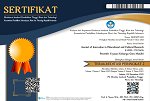The Use of Loose-Part to Improve Early Childhood Self-Sufficiency
(1) Universitas Negeri Yogyakarta, Indonesia
(2) Universitas Negeri Yogyakarta, Indonesia
(3) Universitas Negeri Yogyakarta, Indonesia
(4) Universitas Negeri Yogyakarta, Indonesia
(5) Universitas Negeri Yogyakarta, Indonesia
(6) Universitas Negeri Yogyakarta, Indonesia
Abstract
Keywords
Full Text:
PDFReferences
Arikunto, S. (2010). Penelitian tindakan kelas. Aditya Media.
Askar, N., & Durmusoglu, M. C. (2023). Meaning of Play with Loose Parts Materials in Preschool Education: A Case Study. In Journal of Qualitative Research in Education, 23(33).
Asmanita, M. (2019). Peran Orang Tua Dalam Membentuk Kemandirian Anak Usia Dini Di Desa Tanjung Berugo Kecamatan Lembah Masurai Kabupaten Merangin [Undergraduate Thesis, UIN Sulthan Thaha Saifuddin Jambi].
Cankaya, O., Rohatyn-Martin, N., Leach, J., Taylor, K., & Bulut, O. (2023). Preschool children’s loose parts play and the relationship to cognitive development: A review of the literature. Journal of Intelligence, 11(8).
Casey T., & Robertson, J. (2019). Loose parts play a toolkit acknowledgements. Inspiring Scotland.
Caterpillar. (2009). Parts manual. October, 44(October), pp. 1–34.
Daly, L., & Beloglovsky, M. (2015). Loose parts: Inspiring play in young children (Vol. 1). Redleaf Press.
Daradjat, Z. (2000). Perawatan jiwa untuk anak. Bulan Bintang.
Firdausi, L. F. L., Hidayah, N. H. N., & Pramono, P. (2022). Peran Guru dalam Pembentukan Karakter Mandiri Siswa Kelompok A dengan Media Buku Halo Balita. Jurnal Ilmiah Pesona PAUD, 9(2), 145-161.
Gibson, J. L., Cornell, M., & Gill, T. (2017). A systematic review of research into the impact of loose parts play on children’s cognitive, social and emotional development. School Mental Health, 9(4), 295–309.
Hutabarat, Z. S., & Phongsavath, P. (2023). Students’ perceptions about the teaching profession: emotional intelligence, critical thinking, and locus of control. Journal of Innovation in Educational and Cultural Research, 4(2), 191–199. https://doi.org/10.46843/jiecr.v4i1.452
Kemmis, S., & McTaggart, R. (1988). The action research planner (3rd ed.). Geelong: Deakin University.
Kiewra, C., & Veselack, E. (2016). Playing with nature: supporting preschoolers’ creativity in natural outdoor classrooms. The International Journal of Early Childhood Environmental Education, 4(1), 70.
Laksono, R. K. S., Nurcahyo, H., & Wibowo, Y. (2023). Penerapan e-book berbasis socio-scientific issues dalam meningkatkan kemandirian belajar pada materi sistem sirkulasi darah. JINoP (Jurnal Inovasi Pembelajaran), 9(1), 58–69.
Marbiyatun., & Widyasari, C. (2023). Loose part as a learning media to improve early childhood education creativity. Atlantis Press SARL.
Maryatun, I. B. (2016). Peran pendidik PAUD dalam membangun karakter anak. Jurnal Pendidikan Anak, 5(1), 747–752.
Maryatun, I. B., Suparno., & Sugito. (2023). Learning hybridization in Montessori school during pandemic. Hong Kong Journal of Social Sciences, 60(2022), 728-738.
Mastuinda, M., Zulkifli, Z., & Febrialismanto, F. (2020). Persepsi guru tentang penggunaan loose parts dalam pembelajaran di paud se-kecamatan tampan kota pekanbaru. Jurnal Review Pendidikan Dan Pengajaran, 3(1), 90–96. https://doi.org/10.31004/jrpp.v3i1.868
Montessori, M. (1937). Maria Montessori. Helmut Heiland.
Muthmainnah, M., Maryatun, I. B., & Hayati, N. (2016). Pengembangan ular tangga modifikasi (ULTAMOD) untuk mengoptimalkan perkembangan anak. Jurnal Penelitian Ilmu Pendidikan, 9(1).
Nurjanah, N. E. (2020). Pembelajaran STEM berbasis loose parts untuk meningkatkan kreativitas anak usia dini. Jurnal audi: jurnal ilmiah kajian ilmu anak dan media informasi paud, 5(1), 19-31.
Priyanti, N., & Jhoni Warmansyah. (2021). The effect of loose parts media on early childhood naturalist intelligence. Jurnal Pendidikan Usia Dini, 15(2), 239–257. https://doi.org/10.21009/jpud.152.03
Rahardjo, M. M. (2019). How to use loose-parts in STEAM? Early childhood educators focus group discussion in Indonesia. JPUD - Jurnal Pendidikan Usia Dini, 13(2), 310–326. https://doi.org/10.21009/jpud.132.08
Rasimin, R., Luthfi, M., Nurchamidah, N., & Syafaruddin, B. (2022). Contextual Teaching Learning Strategies Through The Anime Movie" Bhineka Tunggal Ika" For Enhancing Student Learning Motives. Golden Ratio of Social Science and Education, 2(1), 47-56.
Rusmansyah, R., Emelia, E., Winarti, A., Hamid, A., Mahdian, M., & Kusuma, A. E. (2023). development of interactive E-modules of PjBL models to improve understanding of colloidal concepts. Jurnal Penelitian Pendidikan IPA, 9(4), 2173-2183.
Safitri, D., & Lestariningrum, A. (2021). Penerapan media loose part untuk kreativitas anak usia 5-6 tahun. Kiddo: Jurnal Pendidikan Islam Anak Usia Dini, 2(1), 40–52. https://doi.org/10.19105/kiddo.v2i1.3645
Sa’ida, N. (2016). Kemandirian anak kelompok a taman kanak ? kanak mandiri desa sumber asri kecamatan nglegok kabupaten blitar. 2, 88–95.
Sardi, M., & Mayar, F. (2023). The effect of loose parts on the development of early childhood creativity. AL-ISHLAH: Jurnal Pendidikan, 15(3), 4120–4128. https://doi.org/10.35445/alishlah.v15i3.4107
Septiani, I., & Kasih, D. (2021). Implementasi metode STEAM terhadap kemandirian anak usia 5-6 tahun di paud alpha omega school. Jurnal Jendela Pendidikan, 1(04), 192-199.
Siantajani, Y. (2020). Loose Parts Material Lepasan Otentik Stimulasi PAUD. PT Sarang Seratus Aksara.
Sukardjo, M., Nirmala, B., Ruiyat, S. A., Annuar, H., & Khasanah5, U. (2023). Loose parts: stimulation of 21st century learning skills (4C Elements). Jurnal Obsesi : Jurnal Pendidikan Anak Usia Dini, 7(1), 1073–1086.
Susanto, A. (2011). Perkembangan anak usia dini (pengantar dalam berbagai aspeknya). Kencana.
Syafi’i, I., & Dianah, N. D. (2021). Pemanfaatan loose parts dalam pembelajaran steam pada anak usia dini. Aulada : Jurnal Pendidikan Dan Perkembangan Anak, 3(1), 105–114.
Syamsudin. A, Maryatun. I.B, & Muthmainah. (2020). Project approach learning of early childhood education program in Indonesia and Malaysia.
Utami, S. Y., Muawwanah, U., & Moha, L. (2023). Implementation of loose-part media to increase creativity in early childhood. Indonesian Journal of Early Childhood Educational Research, 1(2), 87–96.
Yamin, M., & Sanan, J. S. (2013). Panduan PAUD. Gaung Persada Press Group.
Zimmer?Gembeck, M. J., & Collins, W. A. (2006). Autonomy development during adolescence. Blackwell handbook of adolescence, 174-204.
Refbacks
- There are currently no refbacks.
View My Stats

